AIG Bundle
How Does AIG Navigate the Complex World of Insurance Sales and Marketing?
In the ever-evolving insurance industry, understanding AIG's approach to sales and marketing is crucial for investors and strategists alike. Following a significant restructuring, including the Corebridge Financial IPO, AIG has sharpened its focus, fundamentally reshaping its go-to-market strategy. This shift necessitates a deep dive into how AIG secures its competitive advantage and connects with its target audience.
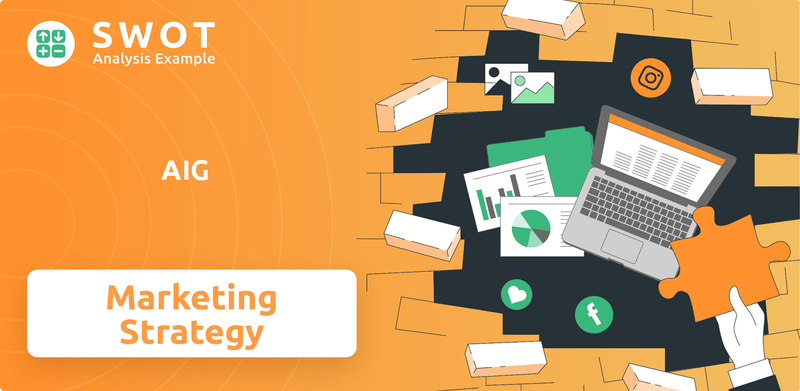
This analysis will dissect AIG's AIG SWOT Analysis, sales and marketing tactics, and brand positioning. We'll explore AIG's digital marketing strategies, customer acquisition strategies, and sales process optimization to understand its current market analysis and future growth potential. Furthermore, we'll examine AIG's marketing campaign examples and sales performance metrics to provide actionable insights into its overall AIG business strategy.
How Does AIG Reach Its Customers?
The sales channels of AIG, a leading global insurance company, are designed to reach a diverse clientele. Their approach combines traditional and digital methods to distribute their property-casualty, life, and retirement products. This multifaceted strategy is crucial for maintaining market presence and adapting to evolving customer preferences.
AIG's distribution strategy relies heavily on a network of independent agents and brokers. These intermediaries are essential for their expertise and established client relationships. They provide personalized service, especially for complex insurance needs. In addition to agents and brokers, AIG uses direct sales teams, particularly for corporate clients.
The company has been strategically investing in its digital presence. This includes enhancing its website for information and direct sales. Strategic partnerships with other financial institutions and affinity groups also contribute to AIG's reach. The performance of these channels varies, with brokers contributing significantly to premium generation, while digital channels are growing in importance for lead generation and customer service.
The broker network is a cornerstone of AIG's distribution strategy. This network provides broad market penetration and personalized service. Brokers are crucial for handling complex insurance needs, ensuring a high level of customer service.
Direct sales teams are particularly important for corporate and institutional clients. They offer tailored solutions and direct engagement. This approach is essential for managing large-scale risk management needs.
AIG is increasing its investment in digital channels. This includes enhancing its website for information and direct sales. These channels are becoming more important for lead generation and customer self-service.
Partnerships with other financial institutions and affinity groups are also key. They allow AIG to offer specialized insurance solutions. These partnerships expand AIG's reach and market penetration.
AIG's sales strategy is designed to optimize customer acquisition strategies. The company's approach to sales reflects a focus on adapting to changing customer preferences and improving efficiency. The evolution of AIG's sales channels shows a strategic shift toward greater digital adoption and omnichannel integration. For a deeper understanding of the competitive landscape, consider reviewing the Competitors Landscape of AIG. The company continues to refine its sales process optimization and sales performance metrics to maintain a competitive advantage in the insurance market. AIG's marketing campaign examples and brand positioning strategy are also key components of its overall business strategy.
AIG's sales strategy combines traditional and digital channels. This approach targets diverse customer segments and adapts to market changes. Digital channels are increasingly important for lead generation and customer service.
- Broker Network: Provides broad market penetration and personalized service.
- Direct Sales: Tailored solutions for corporate and institutional clients.
- Digital Channels: Website enhancements and direct sales portals.
- Strategic Partnerships: Offering specialized insurance solutions.
AIG SWOT Analysis
- Complete SWOT Breakdown
- Fully Customizable
- Editable in Excel & Word
- Professional Formatting
- Investor-Ready Format
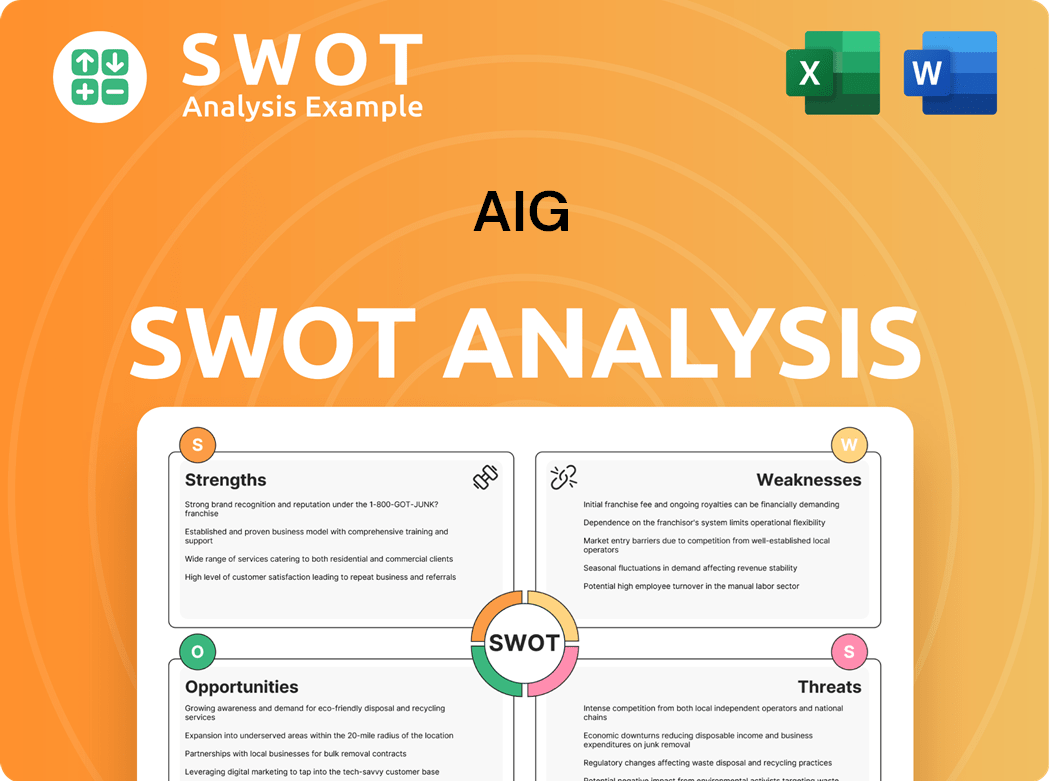
What Marketing Tactics Does AIG Use?
The company employs a multifaceted marketing strategy to boost brand awareness, generate leads, and drive sales across its diverse product portfolio. This approach includes a blend of digital and traditional marketing tactics, all geared towards reaching a broad customer base. The goal is to establish itself as a leader in risk management and financial planning, utilizing data-driven insights to refine its strategies.
Digital marketing plays a crucial role in the company's approach. It leverages content marketing, SEO, and paid advertising to target specific customer segments and promote new offerings. Simultaneously, traditional media channels, such as print advertisements and event sponsorships, are utilized to engage with corporate clients and brokers. The company's approach is increasingly sophisticated, using customer segmentation and personalization to tailor messaging and product offerings.
The company's marketing strategy is data-driven, focusing on customer segmentation and personalization. Analytics tools are used to track campaign performance, measure ROI, and gain insights into customer behavior. This data-driven approach allows for continuous optimization of marketing efforts, ensuring that they remain effective and aligned with evolving customer needs. This approach supports the overall Growth Strategy of AIG.
The company utilizes content marketing, including thought leadership articles, whitepapers, and webinars, to establish itself as an authority. Search Engine Optimization (SEO) is crucial for discoverability, optimizing its online content to rank highly for relevant insurance-related queries. Paid advertising, including SEM and display advertising, is strategically deployed to target specific customer segments.
Email marketing remains a vital tool for nurturing leads, distributing valuable insights, and communicating with existing policyholders. Social media platforms, particularly LinkedIn, are utilized for corporate communications, industry insights, and engaging with business clients and potential talent. This approach supports lead generation strategies.
Beyond digital, the company also utilizes traditional media channels, though often with a more targeted approach, including select print advertisements in industry publications and sponsorships of relevant events and conferences to engage with corporate clients and brokers. This helps in AIG insurance brand positioning strategy.
The company's approach to data-driven marketing is increasingly sophisticated, employing customer segmentation to tailor messaging and product offerings. Personalization is key, especially in its B2B interactions, where solutions are often customized to specific client needs. The company utilizes various analytics tools to track campaign performance.
The marketing mix has evolved significantly, with a greater emphasis on digital engagement and thought leadership content, reflecting the industry's shift towards more informed and digitally-savvy clients. This helps in AIG sales and marketing tactics.
The company focuses on sales performance metrics to measure the effectiveness of its marketing efforts. This includes tracking metrics such as customer acquisition cost, customer lifetime value, and conversion rates. These metrics help optimize the AIG sales process optimization.
The company's marketing strategy is built on several key elements, including digital marketing, content creation, and data analytics. These elements work together to enhance the company's market presence and drive sales. The strategy also focuses on customer relationship management and sales funnel optimization.
- Content Marketing: The company produces thought leadership articles, whitepapers, and webinars to establish itself as an industry expert.
- SEO and SEM: SEO is used to improve online visibility, while SEM targets specific customer segments through paid advertising.
- Email Marketing: Email campaigns are used to nurture leads and communicate with existing customers.
- Social Media: Platforms like LinkedIn are used for corporate communications and engaging with clients.
- Data Analytics: Data analytics are used to track campaign performance and gain insights into customer behavior.
AIG PESTLE Analysis
- Covers All 6 PESTLE Categories
- No Research Needed – Save Hours of Work
- Built by Experts, Trusted by Consultants
- Instant Download, Ready to Use
- 100% Editable, Fully Customizable
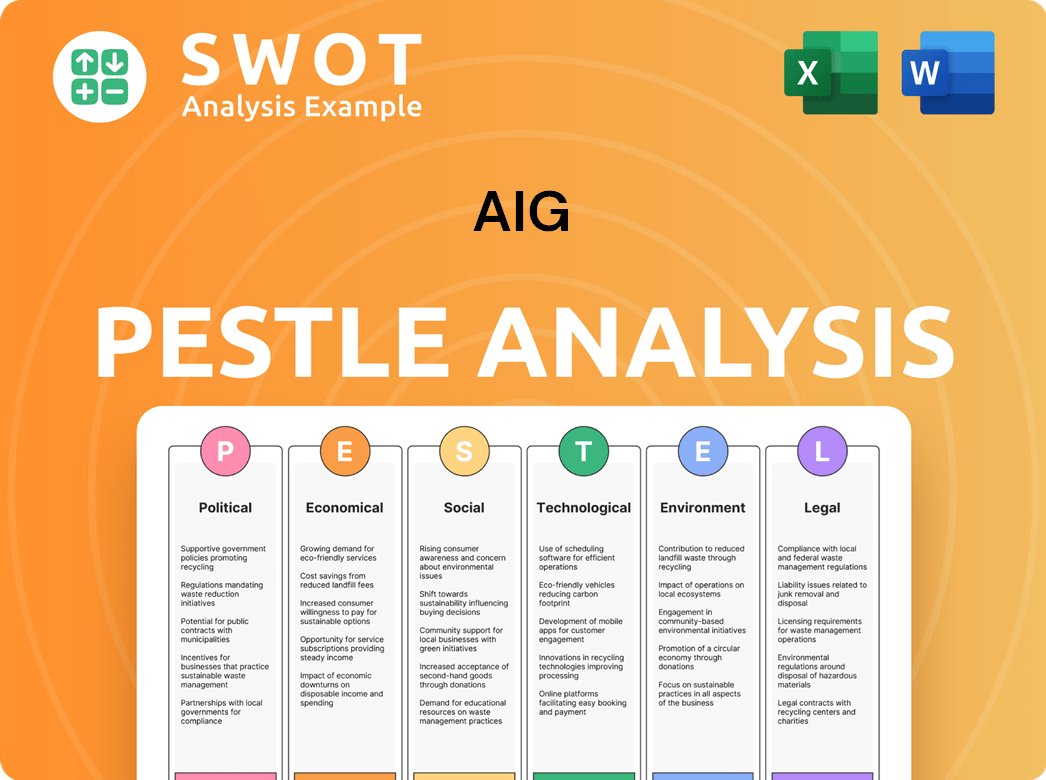
How Is AIG Positioned in the Market?
AIG's brand positioning centers on its status as a global leader in insurance and financial services. The company emphasizes its extensive expertise, financial strength, and commitment to providing comprehensive risk solutions. This approach aims to build trust and confidence among its diverse clientele, which includes both large corporations and individual policyholders. The brand's visual identity and communication style are designed to convey stability, professionalism, and trustworthiness.
The core message of AIG revolves around security, reliability, and partnership. AIG strives to offer a customer experience characterized by deep industry knowledge, responsive service, and tailored solutions. This is particularly important in today's market, where clients seek comprehensive coverage and bespoke solutions to manage complex and evolving risks. AIG's brand consistently reinforces its commitment to helping clients manage risk and achieve financial security.
AIG differentiates itself through its global reach and specialized expertise, particularly in handling complex and large-scale risks. The company actively adapts its messaging to highlight its resilience and innovative solutions, especially in areas like cyber insurance and climate risk. According to recent reports, the global insurance market is projected to reach $7.2 trillion in 2024, with continued growth expected in the coming years. AIG's ability to navigate this dynamic landscape is crucial for maintaining its competitive advantage. For more insights into AIG's target market, you can refer to this article: Target Market of AIG.
AIG leverages its deep industry knowledge and substantial financial resources to offer tailored risk management solutions. This focus helps in attracting and retaining clients who value comprehensive coverage and bespoke services. This approach is key to its AIG sales strategy.
AIG's global presence allows it to address complex, large-scale risks across various industries. This international footprint is a significant aspect of its AIG marketing strategy, enabling it to serve a diverse client base. The company's ability to adapt to evolving market needs is a key element of its AIG business strategy.
AIG prioritizes a customer-centric approach, focusing on responsive service and building long-term partnerships. This strategy is essential for customer retention and loyalty. This is a critical component of AIG customer acquisition strategies.
AIG continuously innovates and adapts its offerings to meet emerging risks, such as cyber threats and climate change. This proactive stance strengthens its market position. This is a core element of AIG digital marketing strategies.
AIG's brand positioning strongly emphasizes its expertise in risk management. This includes offering solutions for complex and evolving risks, which is a key differentiator in the insurance market. This focus is integral to AIG brand positioning strategy.
AIG maintains strong brand consistency across its numerous subsidiaries and global operations. This ensures a unified message and experience for clients worldwide. This consistency is crucial for AIG sales and marketing tactics.
The company actively monitors consumer sentiment and competitive threats. This allows AIG to adapt its messaging to highlight its resilience and innovative solutions. This is important for AIG lead generation strategies.
AIG consistently reinforces its commitment to helping clients manage risk and achieve financial security. This message resonates with both individual policyholders and corporate clients. This focus is essential for effective AIG customer relationship management.
While not a luxury brand, AIG's offerings often cater to sophisticated clients who value comprehensive coverage and bespoke solutions. This targeting helps in maximizing returns. This is crucial for AIG sales process optimization.
AIG uses data and analytics to refine its sales and marketing strategies. This includes analyzing customer behavior, market trends, and sales performance metrics. This data-driven approach is vital for AIG sales performance metrics.
AIG Business Model Canvas
- Complete 9-Block Business Model Canvas
- Effortlessly Communicate Your Business Strategy
- Investor-Ready BMC Format
- 100% Editable and Customizable
- Clear and Structured Layout
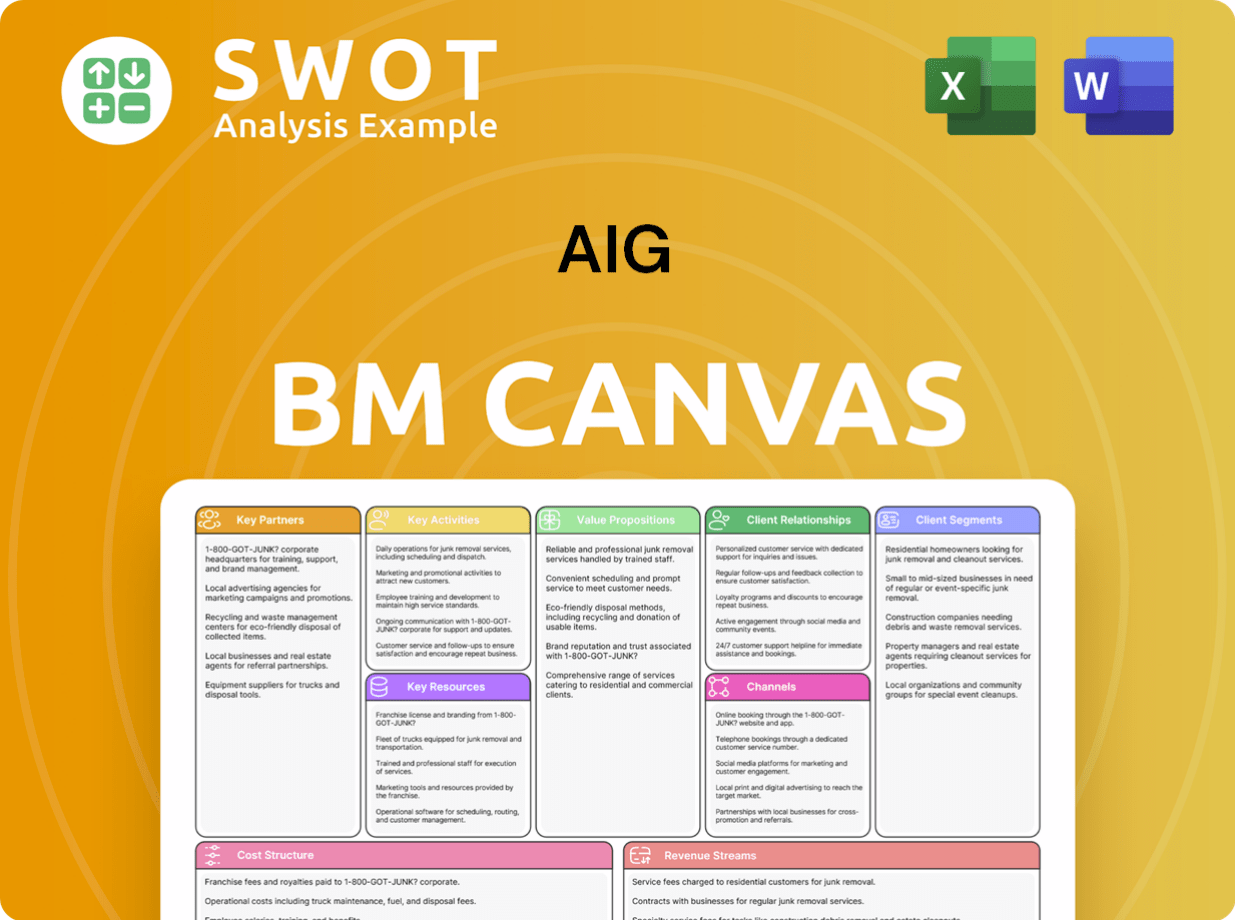
What Are AIG’s Most Notable Campaigns?
The sales and marketing strategy of AIG involves several key campaigns designed to maintain and enhance its market position. AIG's approach is multifaceted, encompassing strategic repositioning, targeted marketing initiatives, and continuous efforts to highlight its expertise in specific insurance niches. These campaigns are crucial for driving revenue growth and reinforcing AIG's brand in a competitive market. Understanding these strategies is essential for anyone interested in AIG sales strategy.
One of the primary focuses of AIG's marketing efforts involves emphasizing its specialized insurance offerings. These campaigns often target specific sectors, such as commercial property or cyber insurance, to address emerging risks and showcase AIG's capabilities. By focusing on these niche areas, AIG aims to capture a larger share of the market and establish itself as a leader in providing tailored insurance solutions. These efforts contribute to AIG's overall business strategy.
A significant ongoing 'campaign' for AIG has been its strategic repositioning and communication around its focused business model. This involved extensive investor relations and public relations efforts. The objective was to clearly articulate AIG's renewed focus on its property-casualty business, enhance investor confidence, and redefine its market identity. This strategic shift is a core component of AIG’s overall approach.
AIG has been actively communicating its focused business model, especially after the separation of Corebridge Financial. This involved extensive investor relations and public relations efforts to enhance investor confidence. The main channels included financial news outlets and investor conferences. This campaign aims to redefine AIG's market identity.
AIG frequently highlights its expertise in specialized insurance niches, such as cyber insurance. These campaigns include thought leadership content and targeted advertising to educate businesses on emerging risks. The creative concept typically emphasizes protection and proactive risk management to generate leads.
AIG's marketing efforts also focus on highlighting its expertise in commercial property insurance. These campaigns aim to educate businesses about risk management. Such campaigns contribute to AIG's market share in these growing segments, as evidenced by its continued presence and offerings in complex risk areas.
Campaigns are designed to generate leads and position AIG as a leader in specialized risk solutions. While specific sales lift figures are proprietary, such campaigns contribute to AIG's market share. These efforts are crucial for AIG's customer acquisition strategies.
AIG's marketing strategy includes various tactics to reach its target audience effectively. These tactics support AIG's sales process optimization.
- Investor Relations: Regular communication with investors to maintain confidence and clarify the company's focus.
- Thought Leadership: Creating and distributing content that positions AIG as an expert in specific insurance areas.
- Targeted Advertising: Focusing advertising efforts on specific industries or risk areas.
- Digital Marketing: Utilizing digital channels to reach a broader audience and generate leads.
For more insights into AIG's overall strategic direction, a review of the Growth Strategy of AIG can provide additional context. These campaigns and strategies are vital components of AIG's competitive advantage.
AIG Porter's Five Forces Analysis
- Covers All 5 Competitive Forces in Detail
- Structured for Consultants, Students, and Founders
- 100% Editable in Microsoft Word & Excel
- Instant Digital Download – Use Immediately
- Compatible with Mac & PC – Fully Unlocked
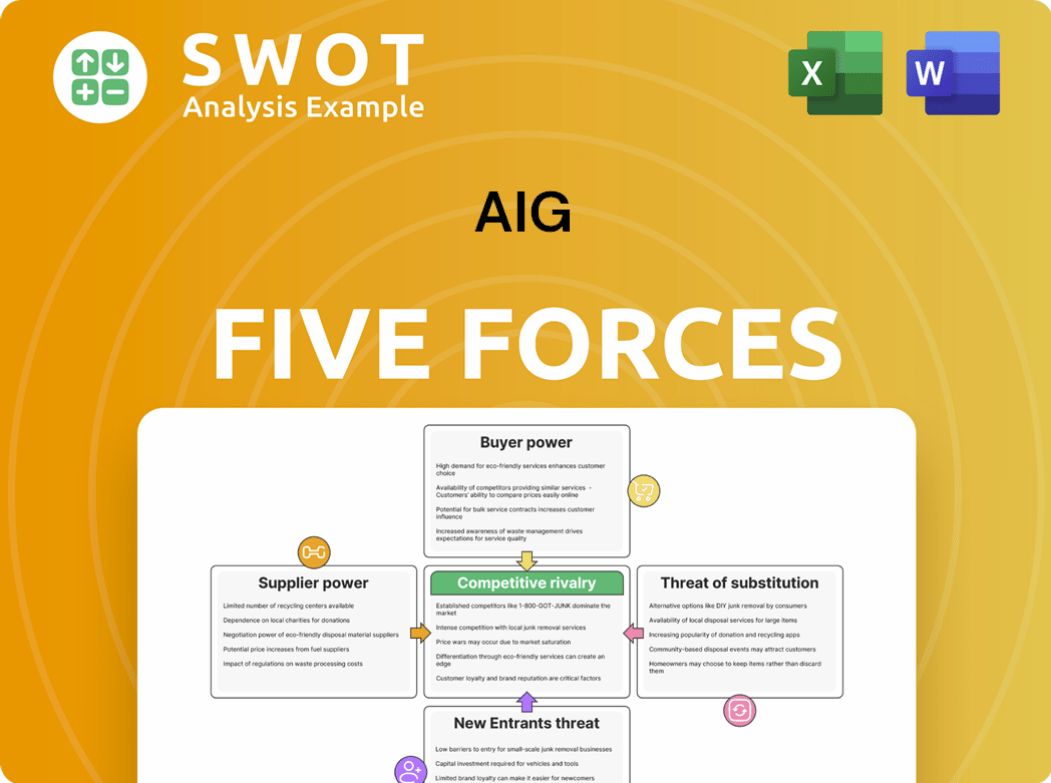
Related Blogs
- What are Mission Vision & Core Values of AIG Company?
- What is Competitive Landscape of AIG Company?
- What is Growth Strategy and Future Prospects of AIG Company?
- How Does AIG Company Work?
- What is Brief History of AIG Company?
- Who Owns AIG Company?
- What is Customer Demographics and Target Market of AIG Company?
Disclaimer
All information, articles, and product details provided on this website are for general informational and educational purposes only. We do not claim any ownership over, nor do we intend to infringe upon, any trademarks, copyrights, logos, brand names, or other intellectual property mentioned or depicted on this site. Such intellectual property remains the property of its respective owners, and any references here are made solely for identification or informational purposes, without implying any affiliation, endorsement, or partnership.
We make no representations or warranties, express or implied, regarding the accuracy, completeness, or suitability of any content or products presented. Nothing on this website should be construed as legal, tax, investment, financial, medical, or other professional advice. In addition, no part of this site—including articles or product references—constitutes a solicitation, recommendation, endorsement, advertisement, or offer to buy or sell any securities, franchises, or other financial instruments, particularly in jurisdictions where such activity would be unlawful.
All content is of a general nature and may not address the specific circumstances of any individual or entity. It is not a substitute for professional advice or services. Any actions you take based on the information provided here are strictly at your own risk. You accept full responsibility for any decisions or outcomes arising from your use of this website and agree to release us from any liability in connection with your use of, or reliance upon, the content or products found herein.